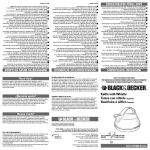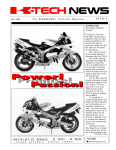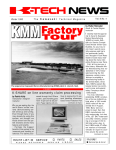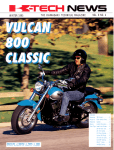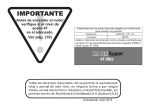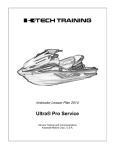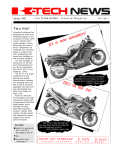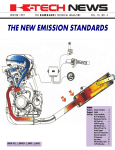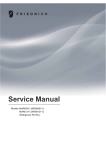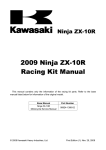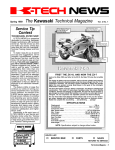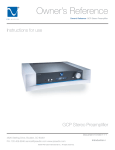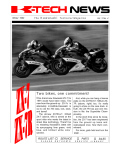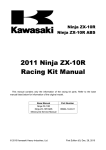Download K-Tech News Vol.11 No.3
Transcript
FA L L 1 9 9 8 THE K AWA S A K I TECHNICAL MAGAZINE VOL. 11, NO. 3 1999 ULTRA 150 INSIDE Feature Regional News Tech Tips ROUTE LIST ❑ SERVICE ❑ PARTS ❑ SALES P L E A S E R E T U R N T O S E R V I C E L I B R A R Y New for ’99 . . . . . . . . . . . . . . 2 Update . . . . . . . . . . . . . . . . . 4 VICA Skill Olympics . . . . . . . . . 5 Hotline Technician. . . . . . . . . . 6 KAPS Training Video . . . . . . . . 6 Generator Model Codes . . . . . . 7 KHI Facts . . . . . . . . . . . . . . . . 8 Latin Tech Seminar . . . . . . . . . 9 Service Contest. . . . . . . . . . . . 9 Tool Corner . . . . . . . . . . . . . 10 900STX Carburetor . . . . . . . . 10 ZX-900CI Manual . . . . . . . . . 10 Saddlebag Shims . . . . . . . . . 11 KE1000 Forks . . . . . . . . . . . 11 Prairie High Beams. . . . . . . . 12 JH750-B2, B3 Trim . . . . . . . . 12 KDX200 Manual. . . . . . . . . . 13 KX Jetting . . . . . . . . . . . . . . 13 Fuel Filter . . . . . . . . . . . . . . 13 Engine Compression . . . . . . . 14 Generator Warranty . . . . . . . 14 Original Parts Kits. . . . . . . . . 15 KX, KDX, KLX Axles . . . . . . . 15 Cover Story New for ’99 jacket, not joining the by Ray St. John Supervisor, Technical Writing reaches the water box The mixedflow pump is compact and efficient, and shimmed for tip clearance. exhaust gas flow until it muffler. This keeps steam from blocking the exhaust flow to help produce 1999 JET SKI® Ultra 150 The most interesting more power. Rubber engine mounts, two at the rear and one in part of this new boat is the front, work with new probably its engine. The dual counter-rotating bal- three separate cylinders ancers to cancel vibration. displace a total of 1,176cc, The balancers are gear thanks to a bore and driven off each end of the stroke of 80 x 76mm. crankshaft, and are com- Three 40mm, downdraft, pletely contained in the mixed-flow jet pump fast they’re going) by constant velocity carbure- crankcases. Output from turns 145 horsepower into checking out the new dig- tors feed the crankcase the engine’s new variable 904 pounds of thrust. It is ital meter system through 8-petal reed output oil pump keeps the first mixed-flow pump mounted on the dash. It blocks, helping this big their bearings lubed. for Kawasaki since the includes a speedometer, JET SKI 550 SX and it tachometer, fuel level triple put out an honest neto. The new Ultra 150 To stuff this big engine keep up to date on how things are going (and how 145 horsepower at 7000 into the hull, Kawasaki’s works the same way. As gauge and warning light, rpm. The CV carbs allow engineers leaned the cylin- water passes through the an engine oil level gauge the engine to idle ders over at a 45˚ angle pump, it not only flows and warning light, an smoothly and respond to toward the starboard side, axially along the pump, engine temperature throttle quickly while plugged the carbs into the but spreads radially out- warning light, an hour putting out fewer exhaust crankcase at 90˚ to the ward. By taking advan- meter, a clock, a low bat- emissions. cylinders, then located the tage of the natural ten- tery voltage warning huge expansion chamber dency of the water to light, and a slick nozzle by a completely dry over the resulting “V.” spread outward under trim indicator. exhaust system that keeps The installation is remark- centrifugal force as it’s cooling water in the ably compact. being spun around by the is hand-laid fiberglass, impeller, the mixed flow reinforced with bulk- on the flywheel dramati- pump is more efficient for heads. This design is cally cut weight (from 5.6 its size than an axial flow lighter than a double hull, to 1.9 pounds) for a quick pump. An oval leading and allows the engine to revving engine. A smaller edge impeller resists cavi- be mounted lower in the starter also cuts weight. tation. hull to keep the center of Power output is aided exhaust system’s water Neodymium magnets To keep the Good The DC-powered CD igni- Tough Nikasil coating transfers heat quickly and eliminates the heavy steel liners. The new, deep-V hull gravity as low as possible. tion system on this boat Times going as long as A Kawasaki Splash allows the magneto to be possible, the giant fuel Deflector on the bow smaller because it uses tank holds 16.4 gallons of assures a drier ride and battery power instead of gas. The oil tank holds 1.2 the recessed bow eye is a drawing from the mag- gallons. The operator can thoughtful detail. The Cont’d on page 3 FALL 1998 2 K-TECH NEWS Cover Story K-TECH News Vol. 11, No. 3 Fall 1998 K-TECH News Staff Publisher Kawasaki Tech Services Publications Manager Don Church Executive Editor Gary Herzog Editor-in-Chief Gregg Thompson Communications Editor John Griffin Regional Editors Piscataway/Grand Rapids Fred DeHart Atlanta/Dallas Walter Rainwater Irvine/Tacoma Robert Taylor Contributors David Behlings, Dave Corey, Carlos Johnston, Craig Martin, Keith Pestotnik, John Pomo, Ray St. John Graphics/Production Graphic Art Gregg Thompson Photography Dave Corey Production Holland Marketing Services ©1998 Kawasaki Motors Corp., U.S.A. All rights reserved. Published by Kawasaki All suggestions become the property of KMC. Sending a service suggestion gives Kawasaki permission to publish and/or use it without further consideration. Specifications subject to change without notice. 1999 Vulcan™ 1500 Drifter As you can see, styling is the Drifter’s long suit, but high-tech has not been neglected. Digital fuel injection feeds the engine on a Kawasaki motorcycle in the U.S. market for the first time since the 1986 Voyager. The new DFI system has two 36mm throttle plates, one controlling the input to each cylinder. In each intake tract, a single injector with four individual orifices squirts the fuel at the intake valves, two holes per valve. When the engine is under light loads (cruising at moderate speeds or idling), the injection system uses intake tract pressure and engine speed to calculate the amount of fuel needed. Under heavier loads, the system looks at the throttle opening and engine speed to figure fuel needs. Horsepower is up from the Vulcan 1500 Classic and Nomad engines thanks to the fuel injection system, more compression, and “hotter” cam timing borrowed from the original Vulcan 1500. Fuel economy is better as well. Unlike earlier systems, the Drifter fuel injection has an automatic fast idle and cold start capability. Most riders may never need it, but the Drifter does have a starting knob for extreme conditions. The electrical system has a new 20 amp/hour battery and the Nomad’s high output, dual alternator. The new frame has extra-large diameter 42.7mm tubes, and a large diameter steering head pipe, with bigger steering bearings and gussets. The front fork offset splits the difEach cylinder has its own intake tract. ference between the FALL 1998 3 K-TECH NEWS Classic at 60mm and the Nomad at 5mm with a 25mm figure. It shares tire sizes with the Classic: a 130/90-16 on the front, and a 150/80-16 on the back. The rear fender is mounted on the swingarm so it rides close to the rear tire and gives the Drifter a distinctive, lowslung look. Lay-down air shocks with 4-way rebound damping give the Drifter more rear wheel travel than either the Classic or the Nomad. The rider’s footboards are in the same place as on the Nomad, 65mm farther back than the Classic’s, for a more upright riding position. Self-canceling turn signals add to rider convenience and a multi-plane reflector headlight with a clear lens has a bright beam and gives the front end a unique look. Cont’d on page 16 Regional PISCATAWAY/ GRAND RAPIDS Put Them On Hold -- Lose the GOLD$$ Doing business in today’s market requires us to spend our time wisely. To that end, I find more and more dealerships using automatic phone answering equipment with entertaining and informative messages. In the course of doing my job, I call a lot of dealerships. As expected, I get put on hold quite often. This is not a problem until I have experienced the dealership’s complete message answering theme and their plans for the next millennium! How long have I been put on hold? Anywhere from ten minutes, to a half-hour, and there have been times when no one ever picked up. If I were a retail customer, I would be long gone and the dealership would lose the chance to sell me goods or services. If your dealership likes to make money and aggressively seeks floor traffic, you can’t afford to leave your customers on hold for any great length of time. Put them on hold and you will lose the $$gold$$. How long can you keep a customer on hold and not lose them? Not very long! Most recommendations I have seen are for 30 seconds to one minute. After that, store personnel should pick up and talk with the customer or offer to call them back. Make sure you call them back if you agree to do so. With a busy fall selling season here, now is a good time to make sure your customer sales and service opportunities are not put on hold! Fred DeHart 201 Circle Drive N. #107 Piscataway, NJ 08854 (908) 469-1221 IRVINE/TACOMA near Tulsa, Oklahoma from Cedar Valley Community College. Tulsa Technology Center will be our official Kawasaki Training Center for the central region. Starting in December 1998, all central region classes will be held on their southeast campus at 4600 South Olive in Broken Arrow, Okla. Since Tulsa is more centrally located in this region, it gives more dealers easier access to Kawasaki Technical Training. Check out the 1998/99 training schedule already sent to your dealership for all classes including those at Tulsa Technology Center. To register for classes held at Tulsa Technology Center, contact Kawasaki’s Fort Worth sales office at (817)589-1180. We have a map and local hotel list available if you request them. See you there! Walter Rainwater 6110 Boat Rock Blvd. S.W. Atlanta, GA 30378 (404) 349-2000 ATLANTA/DALLAS We Are Moving! Kawasaki is proud to announce the relocation of our central region training center. We are moving to Tulsa Technology Center, FALL 1998 4 K-TECH NEWS Keep Up-to-Date What helps a service manager or technician perform their day-to-day jobs better? Kawasaki’s Service Update seminars, of course! November is only days away, the month that we hit the road to start the seminars. Because of the large turnout last year, we now visit 35 cities! A Temporary Service Bulletin dated September 18, 1998, was sent to your dealership. It lists the cities and dates of the seminars. To simplify enrollment, there is now only one location to call for information and to register: the National Training Center in Irvine, Calif., at (949) 770-0400, ext. 2452. Although the primary information given at the Service Update ’99 seminar is service-related, we are often asked questions regarding a parts department problem or a salesrelated issue. Kawasaki’s instructors wear many hats; as an example of this, we taught the KIC News training last year and also teach service and parts department management classes. We teach ATV, motorcycle, Mule utility vehicle, and Jet Ski watercraft classes as well as attend many sales events such as Daytona Bike Week or Americade in service support. The instructors wear other hats including managing special tools, developing training videos, Hotline support, contributing to informational booklets such as the Product Sales Guides and How We Stack Up, and service bulletins. I think we can help with your problem! If not, we will connect you with a specialist who can. Service Update ’99 will include new products such as the all-new Jet Ski® Ultra 150, Vulcan™ 1500 Drifter, motorcycle fuel injection, CVT systems, as well as all service department issues: bulletins, recalls, warranty, in-field product problems, and of course, addressing your specific problems. Plan to be there and sign up early as many of the locations have capacity limits!◆ Rob Taylor 9950 Jeronimo Road Irvine, CA 92618 (949) 770-0400 Motorcycle Service Technology Contest VICA Skill Olympics in Kansas City by Ray St. John Supervisor, Technical Writing Kansas City, Missouri. Late June 1998. The weather is hot and muggy. More than 2,000 high school and post-secondary students from industrial and vocational/technical programs around the country have come together to test their skills against their peers. They are all members of the Vocational Industrial Clubs of America, VICA, and each has won the state contest in his or her home state. Who among them will be the best carpenter, bricklayer, bakery chef, hairdresser, diesel mechanic, draftsman? And Kawasaki Motors Corp., U.S.A., is here to VICA judges from KMC and Intertech Publishing. help run the Motorcycle Service Technology Contestant ponders the inner workings of a Vulcan™ 500 LTD fork. He got it right. FALL 1998 5 Contest, along with Honda, Yamaha, Motorcycle Mechanics Institute, Snap-On Tools, and the Motorcycle Industry Council. Twenty-seven students are here, too, from all over the U.S., and each is ready to prove that he or she is the best student motorcycle mechanic for 1998. They must finish a three-hour written exam and go through six halfhour, hands-on, work stations during the course of clutch inspection. Every half-hour during the day, the students move to another station or return to the written exam. At the end of the day, everyone is tired. All the contestants have done their best. And even though only six will take home the honors, each and every one of these students has demonstrated the kind of skill and determination that it takes to compete at the national level. one, grueling day. At nine o'clock sharp the day begins. Some of the students remain in their seats and start on the written exam, twentyfour others begin the work stations: hydraulic fork service, parts identification, electrical troubleshooting, crankshaft bearing service, ignition troubleshooting, and Congratulations to all the contestants from Kawasaki Motors Corp., U.S.A.◆ K-TECH NEWS High School Level Winners: First Place: Joshua Kurtz, Pa. Second Place: Andrew Mehren, Calif. Third Place: Brandon Johnson, N.D. Post Secondary Winners: First Place: Ned Wilson, Minn. Second Place: Tracin Seng, Neb. Third Place: Darwyn Shaw, Texas News Welcome! New Hotline Technician It’s time we got around to introducing Alex Dell, the newest member of our Kawasaki Technical Hotline staff. By now many of you have already spoken to him on the phone. He started working here in April of this year and has been answering the phones through the busy season. Or you may have met him at the Dealer Meeting in Nashville. If you have spoken to him, you no doubt noticed his English accent. Alex was born and raised in England and started his career in the motorcycle press test machines. After doing that for several years, he progressed to industry by working in dealerships near London. He started in the parts department and then moved to the service department as a technician. Alex was able to attend many Kawasaki Training classes because he conveniently lived and worked very near the KMUK (Kawasaki Motors United Kingdom) facility. Before long, Alex had his foot in the door at KMUK, working as their technician preparing the Hotline Technician, and then Road Race Technician. On the race team he wrenched on the Superbikes that competed in England’s National Championship series as well as in selected World Superbike events. After his road racing stint Alex became a Senior R&D Engineer. By the time he left England to start a new life in the U.S., Alex had worked at KMUK for fifteen years. In America Alex settled in the Monterey, California area. He worked as a technician at a couple of local dealerships from 1992 until April of this year, when he came to Southern California to work on the Hotline at KMC. Alex has some interests outside the motorcycle industry, which include flying RC airplanes and helicopters. Recently he has taken up paragliding, a sort of cross between hang-gliding and parachuting. We have no doubt that his years of experience at KMUK as well as in dealerships will make Alex Dell a valuable addition to our Hotline staff.—Ed.◆ New KAPS Training Video by Dave Corey Writer/Producer A new video in the K-TECH training series is now available. Kawasaki Automatic Power-Drive Systems covers the topics you need to get up to speed on this increasingly popular drive system, the continuously variable transmission or CVT. The video includes CVT construction, theory of operation, maintenance, service and troubleshooting as well as high altitude tuning information. The tape is aimed at technicians of all skill levels. The video takes you step-by-step through the process of disassembly and reassembly of the CVTs used in Mules and ATVs. After viewing the video and accompanying reference manual, you will be able to perform basic maintenance, make adjustments, recognize common symptoms, and recommend repair procedures for every type of CVT used in Kawasaki ATV and utility vehicles. If your dealership is a member of the Tech Training Video Club you already received this video at the club price of $25.00 plus shipping, handling, and sales tax. Regular price is $36.95 (plus the usual S & H & tax), but you can join the club and get the tape at the club price by calling Kawasaki Technical Services at (714) 7700400, ext. 2472.◆ FALL 1998 6 K-TECH NEWS News Generators Have Model Codes, Too! by David Behlings Parts Data Coordinator You are very familiar with Kawasaki model codes; you use them when looking for parts or service information for a specific model. For example, how could you find parts for a NINJA™ ZX-9R (model name) without using the model code to narrow your search from six model years to one? (The ZX-9R has been produced from 1994 through 1999.) Until recently, Kawasaki provided generator parts information by model name. But it has become necessary to use product codes. Even though generators don’t have model years, they do change periodically, similar to Mules™. So, to make sure you order the right parts, look for the sticker on the fuel tank above the exhaust outlet showing the complete model code.◆ Here is how you can make sense out of the codes: • The first two letters are the same for name and code. • The third letter represents a number (indicating the size of the generator) as shown: T = 1 (1000) W = 2 (2000) H = 3 (3000) R = 4 (4000) F = 5 (5000) • The eighth character changes according to the generator specification: A, B, C, D, E, etc. This character is the key to finding the right parts catalog for a specific generator. • The last three characters (S00 and S01 above) indicate that these generators are for the U.S. market. V25 and V26, for example, are for Canada. So far, we only have code information for these GA and GE series generators. Model Name Product Code GA1000-A ........................................GAT00A-AS00 GA1400-A ........................................GAT40A-AS00 GE2200-A........................................GEW20A-AS01 GE2900-A........................................GEW90A-AS01 GE4300-A ........................................GER30A-AS01 GE5000-A ........................................GEF00A-AS00 FALL 1998 7 K-TECH NEWS News Akashi Kaikyo Bridge in Kobe Japan. Did You Know? by Gregg Thompson Product Support Supervisor All Kawasaki products are designed under the final authority of Kawasaki Heavy Industries, LTD (KHI) in Japan. KHI is one of the largest corporations in the world. Besides motorcycles and other consumer products, KHI designs and manufactures a wide variety of products, including heavy construction equipment, industrial robots, hydraulic motors, subway cars, bullet trains, jet engines, passenger aircraft, helicopters, large high-speed hydrofoil-type KHI just finished working on the largest single span suspension bridge in the world. watercraft, submarines, supertankers, bridges and much more. Speaking of bridges, Kawasaki just finished working on the largest single span suspension bridge in the world. The recently completed Akashi Kaikyo Bridge in Kobe, Japan, spans a busy FALL 1998 international shipping route, which accommodates up to 1400 oceangoing ships a day. KHI was one of the main contractors on one of the two vertical towers and both of the caissons on which the towers stand. The towers, which reach nearly 1000 feet 8 K-TECH NEWS above the water, were built to vary from true vertical by less than 1/5000th of one degree. For you technicians and specification buffs, that means the towers are off to one side or the other of a perfect vertical line from the base by no more than .040 inch (or 1mm) at the very top! Each tower weighs over 24,000 tons, making them some of the largest structures ever built in water. Each tower also supports an additional weight of 120,000 tons. Here are some other interesting statistics. The caissons that support the towers are over 250 feet in diameter and nearly 200 feet tall (mostly under water) making each one almost the size of a football stadium. To support the caissons 700,000 tons of concrete was poured at the base of each one. And all this was built in water that’s about 150 ft deep and always moving one direction or the other because of the tide! The center span of this 2-1/2 mile bridge is over 6,500 feet long (or almost 1 1/4 miles). By comparison, the central span of the famous Golden Gate Bridge in San Francisco is 4,200 ft long.◆ News Orlando ’98 Latin Technical Seminar by Carlos Johnston Service Support Coordinator, Latin America In June, Kawasaki Motors Corp., U.S.A., offered its second annual Technical Seminar for Latin American Distributors in Orlando, Fla. This two-week-long seminar was taught in Spanish and was open to distributors or dealers in Latin America. We had 13 students with various experience levels from Colombia, Paraguay, Bolivia, Puerto Rico and Guatemala. The Motorcycle Mechanics Institute (MMI) provided a large classroom and fully equipped lab. The course covered an overview of the technology used in all Kawasaki product lines. There was a lot of information and the students were able to set the pace, spending more time on issues of particular interest. Plenty of handson time allowed students to work on engine assemblies, complete motorcycles and watercraft. Thanks go to Mr. Javier Botero from Auteco in Colombia who volunteered as a co-teacher. His experience as a technical Second annual Technical Seminar for Latin American Distributors in Orlando, Florida. instructor in Colombia and knowledge of the “local market ” was very helpful. I would also like to thank the staff of MMI for their support and commitment to this project. Next year we plan to do even bigger and better things. Some students requested more specialized training so we may offer professional-and master-level courses for entry-and master-level technicians.◆ Are You Ready? The Kawasaki Service Contest Is Back! LOOK FOR Enclosed is the first of three quizzes making up HE UIZ N this training season’s Service Contest. Do you remember the Service Contest which ran in the Fall HIS SSUE ’94, Winter ’94, and Spring ’95 K-Tech News issues? Well, this contest is very similar. Here are the details: This issue of K-Tech News brings you the quiz for ATVs and Mule™ utility vehicles. The Winter ’98 issue will contain the motorcycle quiz, and the Spring ’99 issue will wind up the contest with the Jet Ski® watercraft quiz. T Q I T I ! • Each quiz has 50 questions. • The contestant with the highest score total for the three quizzes will win the grand award. In case of a tie, there will be a run-off. • In order to compete for the grand award, all three tests must be completed and returned. • Make copies of the quiz for each person desiring to enter the contest. Anyone in the dealership may compete, however, each contestant must work individually. Faxing the answer sheet is accepted. • Any contestant who scores 86% or higher will win an award for that quiz. • Contestants may use any materials and information to answer the questions. In fact, that is the purpose of this contest to encourage Kawasaki dealership employees to become familiar with Kawasaki products and support materials. • A quiz will be mailed with each of the next two issues of K-Tech News. Winning contestants will be announced in the next issue of K-Tech News. • The deadline for the quiz and where to send it are printed on the quiz. Best of luck.◆ FALL 1998 9 K-TECH NEWS Tech Tips nostic tool. If you want to order this training video, call (949) 770-0400, ext. 2463. Tool Corner New KX Tools by Rob Taylor Supervisor, Curriculum Development New Two-Stroke Engine Pressure Tester Now Available The long awaited twostroke pressure/vacuum engine tester (PN T57001295) is now in stock. This kit comes with everything needed to perform a pressure test on Kawasaki two-stroke engines. The hand pumps, one vacuum and one pressure, are very durable and resist most commonly used chemicals. To ease operation, a check valve in-line with the pump holds pressure during operation. Solid and expansion-type plugs are included. The good news is that all parts can be purchased separately and a complete parts list is included in the kit. Also available from Kawasaki is a Back To The Basics training video titled TwoStroke Engine Pressure Testing. This video comes with a nice manual to assist in learning how to use this important diag- 900STX Carburetor Adjustment by Gregg Thompson Product Support Supervisor It recently came to our attention that the JT900-A1,2 (STX) service manual lists the wrong specification for the low speed mixture screw setting. The book says 7/8 turn out, plus or minus 1/4 turn. You may have problems if you adjust one to that spec. The correct specification is 2 turns out plus or minus 1/4 turn. Be sure to make a note in your shop service manual. The spec is listed on pages 2-4 and 2-11. If you have trouble eliminating an off-idle hesitation by adjusting the low speed mixture screw, try replacing the stock #80 pilot jet with a #82 (PN 16158-3714). With the larger pilot jet installed, you can lean out the low speed screw to about 1 1/4 turns.◆ FALL 1998 10 K-TECH NEWS The KX125-L1 and KX250-L1 have a few new tools. The throttle Sensor Adapter, PN 57001-1414, is required to test the throttle sensor and the Fork Cylinder Holder, PN 57001-1413, is required to disassemble the front fork. The service manual also refers to a peak volt meter to check the ignition coil, pickup coil, and exciter coil output. KMC does not carry this tool but it can be purchased through Kowa Seiki , (800) 824-9655 or K&L Supply Company, (800) 727-6767.◆ Incorrect ZX900-C1 Service Manual Tool Listing The ZX900-C1 service manual (PN 9 9 9 2 4 - 12 2 5 - 01 ) incorrectly directs you to use an Igniter Checker Assembly (57001-1378) to check the igniter. Use a hand tester (PN 57001-1394) to perform the required tests.◆ Tech Tips Nomad Saddlebag Shims by Ray St. John Supervisor, Technical Writing During saddlebag installation on the Vulcan™ 1500 Nomad™, you may need to shim one of the mounting bolts to prevent the saddlebag from being distorted when you tighten the bolts. If the saddlebag is distorted, the cover may not open and close smoothly, or shut and latch securely. The idea is to mount the saddlebag so that both bosses on the top bracket fit snugly against the back of the saddlebag, without bending the bag to fit. The shims are standard parts, and should appear in the parts catalog by the time you read this. To check if the bags fit to the frame, first close and latch the lid. Now fit the protrusions on the bottom of the saddlebag down into the rubber dampers in the bottom bracket, and the hook on the back of the saddlebag into the catch on the top bracket. At this point, the bag is free to move on the Part Number Description Quantity 92022-1317 Shim As Required Note: In the A&P sheet, this shim is called “Flat Washer, Bag.” Reprint: KE100 Front Forks KE100-B Fork Seals We still get calls every now and If a customer comes in with a leaking fork seal on his KE100-B, do you know how to change it? After you get the bike on your lift and the fork tube off and in your hands in record time, the big question comes up: What holds this thing together? There is no damping rod bolt at the bottom to take out and no tension rod at the top. then from dealers who can’t figure out how to get the front forks apart on a B model KE100. The service manual still describes the procedure for disassembling the old style forks. So we decided to reprint an article which was first published in the Fall 1992 issue of K-Tech News. It might be a good idea to make a copy of it and slip it into the suspension disassembly pages of your service manual.◆—Ed. FALL 1998 mounts. Now, lightly press the bag against the top bracket. If both bosses touch the back of the bag without bending or distorting the bag to fit, go ahead and finish mounting the bag. Insert the bolts and tighten them securely. If only one of the mounting bosses touches the bag while leaving a gap at the other boss, the clearance must be measured. Install a mounting bolt through the bag into the boss that is touching and tighten the bolt. Close and latch the lid, and without pushing on the bag, measure the gap at the other mounting boss. If the clearance is less than 1.0mm, go ahead and install and tighten the second bolt. If the clearance is 1.0mm or more, insert shims to take up the clearance. The shims are 1.6mm thick, so the gap must be 2.6mm or more to require two shims. Once you have the clearance down to less than 1.0mm, install and tighten the second bolt. After installing the saddlebag, open and close the lid several times to check for smooth operation. Be sure it latches and locks securely. If it does not work properly, remove the mounting bolts and recheck the clearance.◆ What is holding it together is a bushing, seal, and snap ring. That’s all. Remove the top cap and spring, and drain the oil. Slide the dust boot off the stanchion tube and remove the snap ring and washer that are on top of the seal. Now, clamp the slider in your vise (with soft jaws) at the axle boss and slidehammer it apart. Pull the stanchion tube up hard against the bushing several times until it knocks the bushing and seal out the top of the slider. Before installing the bushing and new seal, check the snap ring groove for burrs. If needed, de-burr it with a three corner file.—John Pomo◆ 11 K-TECH NEWS Tech Tips No High Beams on Your New Prairie®? by Keith Pestotnik Senior Product Quality Engineer We have seen some cases of inoperative high beams on 1999 Prairie® ATVs, including KVF300A/B and KVF400C/D models. The cause has been inside the left hand handlebar switch. Both the 300 and 400 share the same switch assembly, P/N 46091-1726. It may be easier (and quicker) to repair rather than replace the faulty switch. Try this: 1) Remove the 2 switch case screws. 90o Angles Stationary Switch Plate 2) Open the case and inspect the stationary headlight switch contact plate. It’s the black one with 5 red wires soldered to it. The contact plate may be rotated out of its proper position, preventing the sliding switch plate from reaching the high beam contact. If the stationary contact plate has rotated, its (gold-colored) retainer will be bent out of position too. 3) Bend the retainer back to its correct shape: straight with 90˚ angles at each end. You may have to remove this retainer to straighten it. The reshaped retainer will cause the switch contact plate to rotate back where it belongs. 4) Untwist the wire bundle that goes to the upper switch case before reinstalling the retainer. This will provide more slack in the wires to prevent bending the retainer again. 5) Install the switch assembly back onto the handlebars. Be careful not to pinch the untwisted wires! Test the headlights.◆ New Trim Cable for JH750-B2, B3 by Gregg Thompson Product Support Supervisor The Electric Trim Cable for the 1994 and 1995 Super Sport Xi (JH750-B1,B2) watercraft has been substituted to a new part number 590463751. This cable was originally designed for the 1996 JH750-F1, which came with an accordion style boot at the rear end of the cable to keep water Retainer out. The boot is not supplied with the cable. The earlier JH750-B1 and B2 models didn’t have this style boot on the cable. When you install one of these newer style cables on a “B” model watercraft, you must also install the boot (P/N 49016-3702) with two tie wraps (P/N 92037-1173) to keep water from entering the trim system.◆ FALL 1998 12 P/N 49016-3702 K-TECH NEWS Tech Tips KDX200 Service Manual Glitch by Ray St. John Supervisor, Technical Writing On page 4-12 of the KDX200H Service Manual (P/N 999241181-01 and 02), the bottom illustration and the CAUTION beside it are mislabeled. The illustration shows the right-hand subvalve and righthand exhaust rod for the KIPS. But the sub-valve is called “Left,” instead of “Right.” The CAUTION says, “The left sub-valve has a groove [A],“ but it is really the right subvalve that has the groove. The left sub-valve is plain. This error has existed since the manual came out years ago, and has caused some confusion. We hope this clears it up.◆ 1999 KX125, KX250 Jetting Help by Craig Martin, Technical Support Technician Under certain track conditions and rider techniques, some customers have been experiencing significant midrange throttle hesitations on both the 1999 KX125-L1 and KX250-L1. The problem is a rich condition which occurs only at a certain throttle opening (less than full throttle) and a certain rpm in the mid range. Some complicated carburetor characteristics are contributing to this problem making it very difficult to correct. We have come up with some recommended jetting changes which should help if you run into this problem. For the KX125-L1 use the N7NW Jet Needle (P/N 16187-1084) in the 3rd clip position. FALL 1998 For the KX250-L1 use the N3WK Jet Needle (P/N 16187-1079) in the 3rd clip position and a # 58 Power Jet (P/N 161591056). Some additional Power Jets (for the 1998 and 1999 KX125s and KX250s ) have just been made available. The power jets now available are: 13 #48........16159-1058 #50........16159-1053 #52........16159-1055 #55........16159-1054 #58........16159-1056 #60........16159-1057◆ K-TECH NEWS Dirty Carburetor? Check That Fuel Tap Filter by Keith Pestotnik Lead Engineer Quality Assurance Whenever abnormal debris such as bits of plastic, rubber, metal or dirt are found inside a carburetor, repair should include both cleaning the carburetor and inspecting the fuel tap filters. These plastic screen filters, attached to the fuel tap inside the tank, are usually trouble-free. But recently we have heard some reports of fuel tap filter separation—the filter falls out of the fuel tap body and is found bouncing around inside the fuel tank. Of course, with this filter separated from the fuel tap, any debris resting at the bottom of the fuel tank can funnel freely into the carburetor because the fuel tap is at the lowest part of the fuel tank. The micron capacity of the fuel tap filters is designed to stop all but the very smallest particles without inhibiting normal fuel flow. These very small particles can be drained periodically by opening the float bowl drain screw. Larger, easier-to-see particles (the ones that can cause problems in the carburetor) are supposed to remain inside the fuel tank. If you see them in the carburetor float bowl, remember to remove the fuel tap and inspect the filters.◆ Tech Tips Engine Compression by Gregg Thompson, Product Support Supervisor and Charles Yim, Product Quality Engineer cranking pressures will be about 20% below what they are at sea level. This can have negative affects on starting, idling and throttle response. This is especially true with low compression engines such as many of our 2-stroke releases, a leak-down test is a much better way to determine engine condition. A leak-down test is more time consuming and requires different equipment, but in 4-stroke engines it does provide information that the basic compression test does not. Your shop should be equipped to do compression and leak-down tests, and you should perform these tests frequently to help diagnose engine starting or running problems.◆ One of the most basic diagnostic tools for a service technician is the compression test. Any time you are diagnosing an engine for hard starting, poor idling, poor throttle response or low power as well as excessive oil consumption and smoking, one of the first things you should do is a compression test. When doing a compression test, always refer to the specification in the service manual and expect that a good running engine will be within 15% of the HIGH end of the spec. The low end of the compression spec given in Kawasaki service manuals is usually very low—so low that an engine will almost certainly have severe starting and/or running problems if cranking pressures are near that end of the spec. Be aware that the cranking pressures of an engine will go down significantly at higher altitudes. At 5000-6000 feet watercraft engines. This table shows the changes in cranking pressures at higher altitudes for our 1100cc watercraft engines. Many of our 4-stroke engines have automatic compression releases (KACR) which bleed off compression pressure at cranking speeds. With these models it is difficult to diagnose compressionrelated problems with a simple compression test. The amount of pressure bled off by the KACR varies quite a bit between engines, so it’s hard to tell if you might have a modest compression loss due to a problem in the engine. In engines with automatic compression FALL 1998 Kawasaki Portable Generator Warranty In the past, all Kawasaki Portable Generators were sold with a 12-month warranty. As of January 1, 1998, the policy was changed to allow different lengths of warranty depending on the usage of the generator. The new warranty terms are as follows: Kawasaki Generators sold for RETAIL (Personal) use ....................24 months Kawasaki Generators sold for COMMERCIAL use ..........................12 months Kawasaki Generators sold for RENTAL use ....................................6 months The warranty periods for Power Partner Generators remain unchanged. They are as follows: Power Partner Generators sold for RETAIL (Personal) use................24 months Power Partner Generators sold for COMMERCIAL use ........................90 days Power Partner Generators sold for RENTAL use..................................90 days The Kawasaki Warranty Department will soon be issuing a new Warranty Certificate for Kawasaki Portable Generators, but don’t forget the new warranty terms have been in effect since the first of the year.—Ed.◆ 14 K-TECH NEWS Tech Tips Original Equipment Parts Kits Available Kawasaki offers a variety of parts kits including Gasket Kits, Top End Repair Kits and Chain Kits. These kits (especially the gasket kits) can save you lots of time looking up part numbers for big engine jobs. They will also save your customers money because these kits are discount priced. The gasket kits include all applicable gaskets, seals and o-rings including valve guide seals in the Top End and Complete Engine kits. The Top End Gasket kits include everything from the base gasket up. The Bottom End Gasket kits include Part Number Model Application *Complete Engine Gasket Kits 9995-1393 ....................................VN1500-D1/D2 9995-1396 ..............................ZX1100-D1 thru F2 9995-1399 ....................KX250-K1/K2/K3/K4/K5 everything below the base gasket. The Top End Repair kits (for KX bikes only) include parts needed for multiple maintenance intervals. Each kit includes a piston, wrist pin, bearing, and circlips, two sets of rings, 3 head gaskets and 2 each of the other top end gaskets. The Chain kits include the front and rear sprockets and the chain. They do not include replacement lock washers or tabs so be sure to order separately any lock washers you will need for the job. Here is a list of the kits currently available.◆—Ed. Part Number Model Application 99995-1394 ........................................VN800-A1 thru B4 99995-1397 ..........................................ZX600-F1/F2/F3 *Top End Gasket Kits 99996-1245..............................ZX1000-A1/A2/A3 99996-1248 ............................ZX900-A1 thru A10 99996-1251..........................EN, EX500-A1 thru F3 99996-1255 ................................ZX750-L1/L2/L3 99996-1262 ......................KZ, ZN1300-A1 thru A6 99996-1276 ......................................ZX900-C1/C2 99996-1247........................................ZX1000-B1/B2/B3 99996-1249........................................ZX600-A1 thru C10 99996-1253....................................ZX900-B1/B2/B3/B4 99996-1257 ....................................ZX750-P1/P2/P3/P4 99996-1274................................................ZX600-G1/G2 *Bottom End Gasket Kits 99996-1246 ................ZN900, ZX1000-A1 thru B3 99996-1252....................EN, ER, EX500-A1 thru F3 99996-1254 ........................ZX900-B1/B2, B3, B4 99996-1263 ................KZ, ZG, ZN1300-A1 thru A6 99996-1277 ......................................ZX900-C1/C2 99996-1250........................................ZX600-A1 thru C10 99996-1254....................................ZX900-B1/B2/B3/B4 99996-1258 ....................................ZX750-P1/P2/P3/P4 99996-1275................................................ZX600-G1/G2 Top End Repair Kits 99996-1234 ......................................KX60-B1-B14 99996-1238......................................KX80-W1/W2 99996-1239 ..........................................KX125-K5 99996-1240 ..........................................KX250-K5 99996-1281............................................KX125-L1 Chain Kits 99996-1202 ..........................................KX125-K4 99996-1203 ..........................................KX250-K4 99996-1207 ......................................EN500-C1-C4 99996-1212 ......................................ZX600-E2-E7 99996-1214 ......................................ZX750-L1-L3 99996-1216 ....................................VN800-B2/B4 99996-1218......................................ZX900-B3/B4 99996-1219....................................ZX1100-D3-D7 99996-1235..................................................KX80-R6/R7 99996-1236......................................................KX125-K4 99996-1237......................................................KX250-K4 99996-1282 ......................................................KX250-L1 99996-1283......................................................KX60-B15 99996-1226......................................................KX125-K5 99996-1227......................................................KX250-K5 99996-1209 ..........................EX500-D1-D2/E1-E4/F1-F4 99996-1213 ................................................ZX600-F1-F3 99996-1215 ................................................ZX750-P1/P4 99996-1217................................................ZX900-B1/B2 99996-1219 ..............................................ZX1100-D3-D7 99996-1222 ....................................ZX1100-E1-E3/F1/F2 *Only gasket kits are display packaged. FALL 1998 15 K-TECH NEWS ’99 KX125-L1 and KX250-L1 Front Axle Installation To ensure minimal fork stiction and keep the wheel from being loose on the axle special assembly is required. Insert the axle and torque the axle nut and then the axle clamp bolts in the left hand fork leg. Then pry open the jaw of the right axle clamp and stroke the fork, allowing the fork legs to center themselves. Now torque the axle clamp bolts in the right hand fork leg.◆ KX, KDX, KLX Front Axle Mount Studs The 6mm studs that thread into the fork legs to secure the front axle are not listed separately on the microfiche but are available. The studs fit the KX 125/250/500 models as far back as 1982, the KDX 200/220R models, and the KLX250/300R models. The Kawasaki part number for these 6 x 20mm studs is 172G0620.◆—John Griffin Cover Story compression and rebound damping, and 5-way spring preload adjusters. This machine has excellent brakes, with 310mm diameter, 5mm thick dual discs up front, clamped by opposed 6-piston Tokico calipers. The 250mm rear disc has an opposed 2-piston caliper. The wheels are threespoke, cast aluminum, 17inchers, with a 3.50-inch rim up front and a 5.0inch rim in the back. The front tire is a 120/70 ZR17; the rear is a 170/60 ZR17.◆ New Models - Cont’d from page 3 ZRX1100 The naked, big bore muscle bike is back. The ZRX1100 engine is based on the ZX-11 motor, but tuned for torque. Around town, and at anything less than all-out racing speeds, what drives the bike is torque, and the more the better. The ZRX motor has everything it needs to make a lot of torque at low engine speeds. The cam timing is milder, and valve lift is a little less. The carburetors are downsized to 36mm, and the exhaust pipe diameter is reduced. The compression ratio is down slightly, to 10.1:1 for smoother low-rpm running. The crankshaft flywheel effect is up 14% so the engine feels even torquier off the line. Internally, the engine has been simplified. The sump is changed to eliminate the second oil drain plug, so oil changes are easier. The oil cooler and its oil pressure relief valve are gone to cut weight. A simple notch in the balancer chamber wall now allows the oil to drain back into the main part of the sump. The engine has been dressed up, too, with polished fins on the ends of the cylinder head, and The modern muscle bike is alive and well. on the crankcase end covers. The digital ignition system incorporates KTRIC, Kawasaki Throttle Responsive Ignition Control. The ignition computer looks at engine load, deduced from throttle position, as well as engine rpm to determine the optimum spark timing. The frame is a tubular, high tensile steel, double cradle, backbone design. It is simple and effective, and has a removable aluminum right-hand downtube to ease engine servicing. The swingarm is tubular aluminum with eccentric chain adjusters (that practically guarantee proper wheel alignment) FALL 1998 and has a sturdy bridge under the main beams, for extra rigidity. The short 57.1-inch wheelbase, 4.1 inches of trail and a fairly steep 25˚ steering head angle give the bike the feel of a 750class machine. The 31.1inch seat height and rubber mounted tubetype handlebars with end weights add to rider comfort. The cartridge forks are 43mm conventional-type, with 12-way compression and rebound damping, and screw-type preload adjusters. The inner fork tubes are 2.5mm thick. The rear shocks are trick units with alumitetreated, external piggyback reservoirs, 4-way 16 K-TECH NEWS So What Else is New? On the waterfront, the three-person JET SKI® 900 STX gets the hull from the 1100 STX, a set of constant velocity carbs, and a digital DC-CDI system. The result is a beautiful handling boat that’s smooth and fast, and more affordable in a competitive market. The 900 STX does not have its big brother’s retractable boarding step, but it has the hardware in the transom so it can easily be bolted on. The digital meter system from the flagship is also carried over to the 900. Of course, the bigger hull means the fuel and oil tanks are bigger as well. On the road, the Vulcan™ 1500 Classic gets the Nomad’s high output alternator and self-canceling turn signals, and California models have catalytic converters in the exhaust system. It also has more comfortable suspension settings, the Nomad’s wider hand levers, and larger radiator with 30% more cooling capacity. All the Vulcan 1500s (except the “A” model) have a new right side crankcase and engine cover that move the oil filler and oil level window to more convenient locations.◆
















